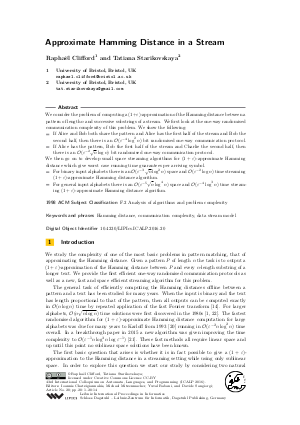Approximate Hamming Distance in a Stream
Authors Raphaël Clifford, Tatiana Starikovskaya
-
Part of:
Volume:
43rd International Colloquium on Automata, Languages, and Programming (ICALP 2016)
Part of: Series: Leibniz International Proceedings in Informatics (LIPIcs)
Part of: Conference: International Colloquium on Automata, Languages, and Programming (ICALP) - License:
 Creative Commons Attribution 3.0 Unported license
Creative Commons Attribution 3.0 Unported license
- Publication Date: 2016-08-23
File

PDF
LIPIcs.ICALP.2016.20.pdf
- Filesize: 476 kB
- 14 pages
Document Identifiers
Subject Classification
Keywords
- Hamming distance
- communication complexity
- data stream model
Metrics
- Access Statistics
-
Total Accesses (updated on a weekly basis)
0PDF Downloads0Metadata Views
Abstract
We consider the problem of computing a (1+epsilon)-approximation of the Hamming distance between a pattern of length n and successive substrings of a stream. We first look at the one-way randomised communication complexity of this problem. We show the following:
- If Alice and Bob both share the pattern and Alice has the first half of the stream and Bob the second half, then there is an O(epsilon^{-4}*log^2(n)) bit randomised one-way communication protocol.
- If Alice has the pattern, Bob the first half of the stream and Charlie the second half, then there is an O(epsilon^{-2}*sqrt(n)*log(n)) bit randomised one-way communication protocol. We then go on to develop small space streaming algorithms for (1 + epsilon)-approximate Hamming distance which give worst case running time guarantees per arriving symbol.
- For binary input alphabets there is an O(epsilon^{-3}*sqrt(n)*log^2(n)) space and O(epsilon^{-2}*log(n)) time streaming
(1 + epsilon)-approximate Hamming distance algorithm.
- For general input alphabets there is an O(epsilon^{-5}*sqrt(n)*log^4(n)) space and O(epsilon^{-4}*log^3(n)) time streaming
(1 + epsilon)-approximate Hamming distance algorithm.
Cite As Get BibTex
Raphaël Clifford and Tatiana Starikovskaya. Approximate Hamming Distance in a Stream. In 43rd International Colloquium on Automata, Languages, and Programming (ICALP 2016). Leibniz International Proceedings in Informatics (LIPIcs), Volume 55, pp. 20:1-20:14, Schloss Dagstuhl – Leibniz-Zentrum für Informatik (2016)
https://doi.org/10.4230/LIPIcs.ICALP.2016.20
BibTex
@InProceedings{clifford_et_al:LIPIcs.ICALP.2016.20,
author = {Clifford, Rapha\"{e}l and Starikovskaya, Tatiana},
title = {{Approximate Hamming Distance in a Stream}},
booktitle = {43rd International Colloquium on Automata, Languages, and Programming (ICALP 2016)},
pages = {20:1--20:14},
series = {Leibniz International Proceedings in Informatics (LIPIcs)},
ISBN = {978-3-95977-013-2},
ISSN = {1868-8969},
year = {2016},
volume = {55},
editor = {Chatzigiannakis, Ioannis and Mitzenmacher, Michael and Rabani, Yuval and Sangiorgi, Davide},
publisher = {Schloss Dagstuhl -- Leibniz-Zentrum f{\"u}r Informatik},
address = {Dagstuhl, Germany},
URL = {https://drops.dagstuhl.de/entities/document/10.4230/LIPIcs.ICALP.2016.20},
URN = {urn:nbn:de:0030-drops-62992},
doi = {10.4230/LIPIcs.ICALP.2016.20},
annote = {Keywords: Hamming distance, communication complexity, data stream model}
}
Author Details
References
-
Karl Abrahamson. Generalized string matching. SIAM Journal on Computing, 16(6):1039-1051, 1987.

-
Noga Alon, Yossi Matias, and Mario Szegedy. The space complexity of approximating the frequency moments. In STOC'00: Proc. 28superscriptth Annual ACM Symp. Theory of Computing, pages 20-29. ACM, 1996.

-
Amihood Amir, Yonatan Aumann, Gary Benson, Avivit Levy, Ohad Lipsky, Ely Porat, Steven Skiena, and Uzi Vishne. Pattern matching with address errors: Rearrangement distances. Journal of Computer System Sciences, 75(6):359-370, 2009.

-
Amihood Amir, Yonatan Aumann, Oren Kapah, Avivit Levy, and Ely Porat. Approximate string matching with address bit errors. In CPM'08: Proc. 19superscriptth Annual Symp. on Combinatorial Pattern Matching, pages 118-129, 2008.

-
Amihood Amir, Yonatan Aumann, Moshe Lewenstein, and Ely Porat. Function matching. SIAM Journal on Computing, 35(5):1007-1022, 2006.

-
Amihood Amir, Richard Cole, Ramesh Hariharan, Moshe Lewenstein, and Ely Porat. Overlap matching. Information and Computation, 181(1):57-74, 2003.

-
Amihood Amir, Estrella Eisenberg, and Ely Porat. Swap and mismatch edit distance. Algorithmica, 45(1):109-120, 2006.

-
Amihood Amir, Martin Farach, and S. Muthu Muthukrishnan. Alphabet dependence in parameterized matching. Information Processing Letters, 49(3):111-115, 1994.

-
Amit Chakrabarti and Oded Regev. An optimal lower bound on the communication complexity of gap-hamming-distance. SIAM Journal on Computing, 41(5):1299-1317, 2012.

-
Raphaël Clifford, Allyx Fontaine, Ely Porat, Benjamin Sach, and Tatiana A. Starikovskaya. The k-mismatch problem revisited. In SODA'16: Proc. 27superscriptth ACM-SIAM Symp. on Discrete Algorithms, pages 2039-2052, 2016.

-
Raphaël Clifford and Benjamin Sach. Pseudo-realtime pattern matching: Closing the gap. In CPM'10: Proc. 21superscriptst Annual Symp. on Combinatorial Pattern Matching, pages 101-111, 2010.

-
Graham Cormode, Mayur Datar, Piotr Indyk, and S. Muthukrishnan. Comparing data streams using Hamming norms (how to zero in). IEEE Trans. on Knowl. and Data Eng., 15(3):529-540, 2003.

-
Mayur Datar, Aristides Gionis, Piotr Indyk, and Rajeev Motwani. Maintaining stream statistics over sliding windows. SIAM Journal on Computing, 31(6):1794-1813, 2002.

-
M. Fischer and M. Paterson. String matching and other products. In Proc. 7superscriptth SIAM-AMS Complexity of Comp., pages 113-125, 1974.

-
Wei Huang, Yaoyun Shi, Shengyu Zhang, and Yufan Zhu. The communication complexity of the Hamming distance problem. Information Processing Letters, 99(4):149-153, 2006.

-
Piotr Indyk. Stable distributions, pseudorandom generators, embeddings, and data stream computation. Journal of the ACM, 53(3):307-323, 2006.

- Markus Jalsenius, Benny Porat, and Benjamin Sach. Parameterized matching in the streaming model. In STACS'13: Proc. 30superscriptth Annual Symp. on Theoretical Aspects of Computer Science, pages 400-411, 2013. URL: http://arxiv.org/abs/1109.5269.
-
Thathachar S. Jayram and David P. Woodruff. Optimal bounds for Johnson-Lindenstrauss transforms and streaming problems with subconstant error. ACM Transactions on Algorithms (TALG), 9(3):26, 2013.

-
William Johnson and Joram Lindenstrauss. Extensions of Lipschitz mappings into a Hilbert space. In Proc. of the Conference in Modern Analysis and Probability, volume 26 of Contemporary Mathematics, pages 189-206. American Mathematical Society, 1984.

-
H. Karloff. Fast algorithms for approximately counting mismatches. Information Processing Letters, 48(2):53-60, 1993.

-
Tsvi Kopelowitz and Ely Porat. Breaking the variance: Approximating the Hamming distance in 1/ε time per alignment. In FOCS'15: Proc. 56superscriptth Annual Symp. Foundations of Computer Science, pages 601-613, 2015.

-
S. Rao Kosaraju. Efficient string matching. Manuscript, 1987.

-
Gad M. Landau and Uzi Vishkin. Fast string matching with k differences. Journal of Computer System Sciences, 37(1):63-78, 1988.

-
Ely Porat. Personal communication, 2016.

